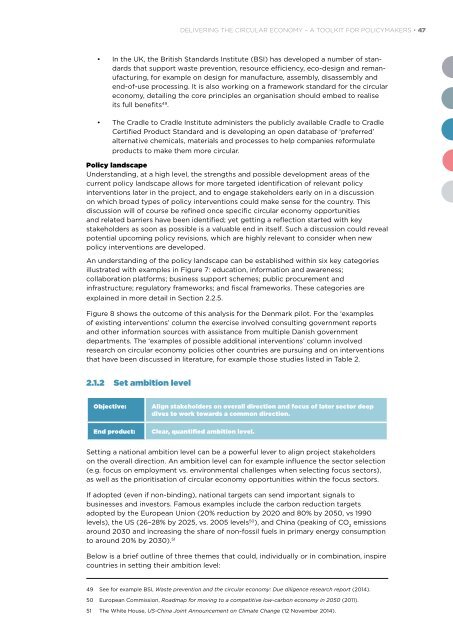DELIVERING THE CIRCULAR ECONOMY A TOOLKIT FOR POLICYMAKERS
20150924_Policymakers-Toolkit_Active-links
20150924_Policymakers-Toolkit_Active-links
Create successful ePaper yourself
Turn your PDF publications into a flip-book with our unique Google optimized e-Paper software.
<strong>DELIVERING</strong> <strong>THE</strong> <strong>CIRCULAR</strong> <strong>ECONOMY</strong> – A <strong>TOOLKIT</strong> <strong>FOR</strong> <strong>POLICYMAKERS</strong> • 47<br />
• In the UK, the British Standards Institute (BSI) has developed a number of standards<br />
that support waste prevention, resource efficiency, eco-design and remanufacturing,<br />
for example on design for manufacture, assembly, disassembly and<br />
end-of-use processing. It is also working on a framework standard for the circular<br />
economy, detailing the core principles an organisation should embed to realise<br />
its full benefits 49 .<br />
• The Cradle to Cradle Institute administers the publicly available Cradle to Cradle<br />
Certified Product Standard and is developing an open database of ‘preferred’<br />
alternative chemicals, materials and processes to help companies reformulate<br />
products to make them more circular.<br />
Policy landscape<br />
Understanding, at a high level, the strengths and possible development areas of the<br />
current policy landscape allows for more targeted identification of relevant policy<br />
interventions later in the project, and to engage stakeholders early on in a discussion<br />
on which broad types of policy interventions could make sense for the country. This<br />
discussion will of course be refined once specific circular economy opportunities<br />
and related barriers have been identified; yet getting a reflection started with key<br />
stakeholders as soon as possible is a valuable end in itself. Such a discussion could reveal<br />
potential upcoming policy revisions, which are highly relevant to consider when new<br />
policy interventions are developed.<br />
An understanding of the policy landscape can be established within six key categories<br />
illustrated with examples in Figure 7: education, information and awareness;<br />
collaboration platforms; business support schemes; public procurement and<br />
infrastructure; regulatory frameworks; and fiscal frameworks. These categories are<br />
explained in more detail in Section 2.2.5.<br />
Figure 8 shows the outcome of this analysis for the Denmark pilot. For the ‘examples<br />
of existing interventions’ column the exercise involved consulting government reports<br />
and other information sources with assistance from multiple Danish government<br />
departments. The ‘examples of possible additional interventions’ column involved<br />
research on circular economy policies other countries are pursuing and on interventions<br />
that have been discussed in literature, for example those studies listed in Table 2.<br />
2.1.2 Set ambition level<br />
Objective:<br />
Align stakeholders on overall direction and focus of later sector deep<br />
dives to work towards a common direction.<br />
End product:<br />
Clear, quantified ambition level.<br />
Setting a national ambition level can be a powerful lever to align project stakeholders<br />
on the overall direction. An ambition level can for example influence the sector selection<br />
(e.g. focus on employment vs. environmental challenges when selecting focus sectors),<br />
as well as the prioritisation of circular economy opportunities within the focus sectors.<br />
If adopted (even if non-binding), national targets can send important signals to<br />
businesses and investors. Famous examples include the carbon reduction targets<br />
adopted by the European Union (20% reduction by 2020 and 80% by 2050, vs 1990<br />
levels), the US (26–28% by 2025, vs. 2005 levels 50 ), and China (peaking of CO 2<br />
emissions<br />
around 2030 and increasing the share of non-fossil fuels in primary energy consumption<br />
to around 20% by 2030). 51<br />
Below is a brief outline of three themes that could, individually or in combination, inspire<br />
countries in setting their ambition level:<br />
49 See for example BSI, Waste prevention and the circular economy: Due diligence research report (2014).<br />
50 European Commission, Roadmap for moving to a competitive low-carbon economy in 2050 (2011).<br />
51 The White House, US-China Joint Announcement on Climate Change (12 November 2014).



